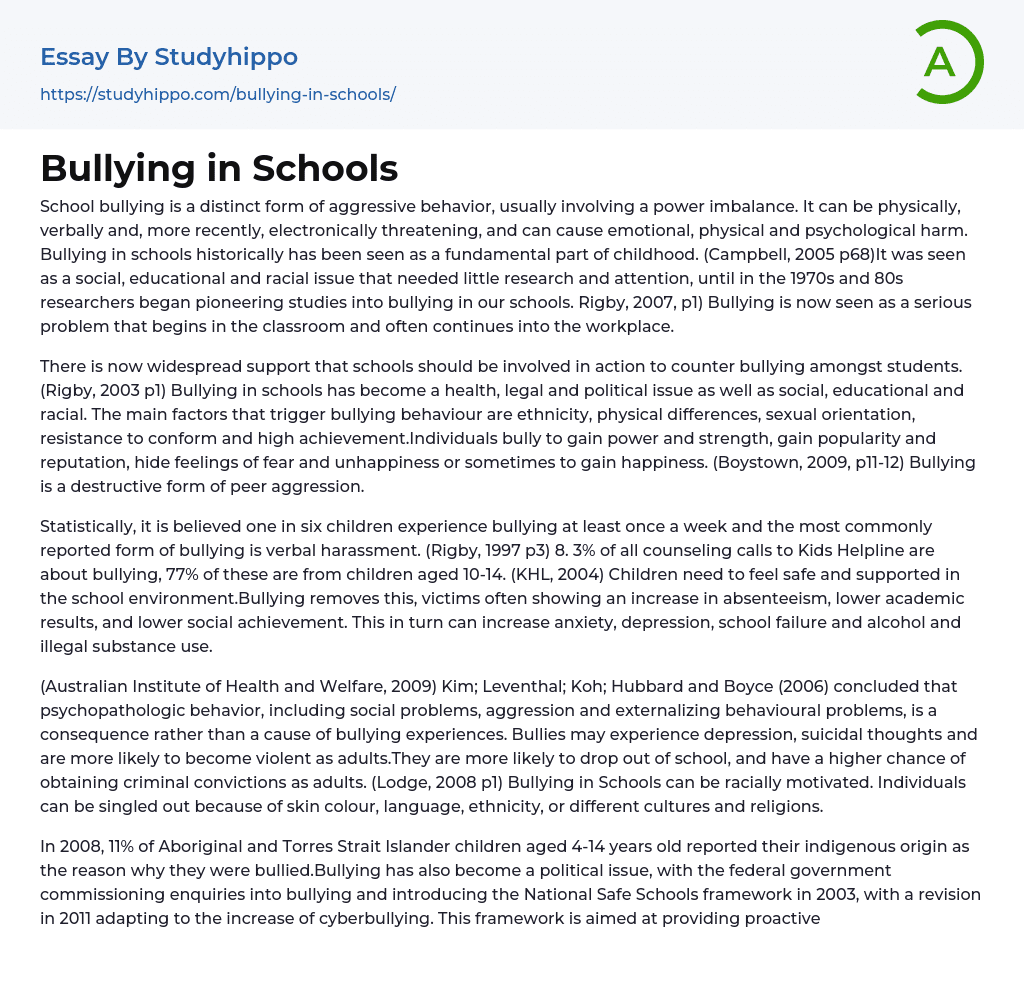School bullying, which can be physical, verbal, or electronic in nature, involves aggressive behavior with a power imbalance. It causes emotional, physical, and psychological harm. In the past, school bullying was seen as a normal part of childhood and received little research or attention. However, starting in the 1970s and 80s researchers began conducting important studies on this issue. Now it is widely recognized that bullying is a significant problem that starts in classrooms but often continues into the workplace.
According to Rigby (2003, p1), there is widespread support for schools addressing bullying among students. Bullying in schools has become a complex issue encompassing health, legal, political, social, educational, and racial aspects. Key triggers of bullying behavior include ethnicity, physical differences, sexual orientation, resistance to conformity, and high achievement. Individuals engage in bullying to ga
...in power or popularity, enhance their reputation or hide feelings of fear and unhappiness; some even seek happiness through it (Boystown 2009,p11-12). Bullying is a harmful form of peer aggression with statistics showing that approximately one in six children are bullied weekly. Verbal harassment is the most commonly reported type of bullying.
According to Rigby (1997, p3), 8.3% of counseling calls to Kids Helpline are associated with bullying. In 2004, KHL reported that 77% of these calls were from children aged between 10 and 14. It is essential for children to feel safe and supported at school; however, bullying undermines this feeling of security. Bullying often results in higher rates of absenteeism, lower academic performance, and reduced social achievements for the victims. Furthermore, it can also lead to increased levels of anxiety, depression, school failure, as well as alcohol and substance abuse.
According to
Kim et al. (2006), bullying experiences can result in psychopathologic behavior, including social problems, aggression, and externalizing behavioral issues. Bullies themselves may suffer from depression, suicidal thoughts, and are more likely to engage in violent behavior as adults. Additionally, bullies have a greater likelihood of dropping out of school and facing criminal convictions later in life (Lodge, 2008 p1). Bullying can also be racially motivated in schools, targeting individuals based on their skin color, language, ethnicity or different cultures and religions. In 2008, 11% of Aboriginal and Torres Strait Islander children aged 4-14 reported being bullied due to their indigenous origin. This issue has garnered political attention leading to government investigations and the implementation of the National Safe Schools framework in 2003. An updated version was introduced in 2011 specifically addressing the emergence of cyberbullying.
This framework aims to provide proactive and practical methods for addressing and combating bullying in schools. Bullying is a pervasive issue that affects every school (Rigby 1997 p9). The impacts of bullying in schools are far-reaching. Therefore, it is crucial to raise awareness and educate families about strategies to prevent bullying, ultimately reducing its occurrence. By promoting strong relationships between parents and students, fostering open communication, and promptly recognizing and addressing bullying behavior, we can work towards decreasing the frequency of these incidents.
The text below contains a list of references. The references are enclosed within .
References
- http://www.ayac.org.au/uploads/Bullying%20Media%20Release.pdf
- Bullying In Schools essays
- Abnormal Psychology essays
- Abraham Maslow essays
- Attachment Theory essays
- Authority essays
- Behaviorism essays
- Classical Conditioning essays
- Cognitive Psychology essays
- Counseling essays
- Developmental Psychology essays
- Educational Psychology essays
- Erik Erikson essays
- Family Therapy essays
- Jean Piaget essays
- Maslow's Hierarchy Of Needs essays
- Mental Health essays
- Operant Conditioning essays
- Personality Psychology essays
- Positive Psychology essays
- Psychoanalysis essays
- Psychotherapy essays
- Sigmund Freud essays
- Social Psychology essays
- Stanford Prison Experiment essays
- Supersize Me essays
- Adult essays
- Aggression essays
- Altruism essays
- Archetype essays
- Behavior essays
- Certainty essays
- Conformity essays
- Deception essays
- Human Behavior essays
- Human Sexuality essays
- Maturity essays
- Morality essays
- Obedience essays
- Procrastination essays
- Reinforcement essays
- Role Model essays
- Abortion essays
- Abuse essays
- Animal Rights essays
- Animal Testing essays
- Assault essays
- Bullying essays
- Controversial Issue essays
- Crash essays
- Cyber Bullying essays




